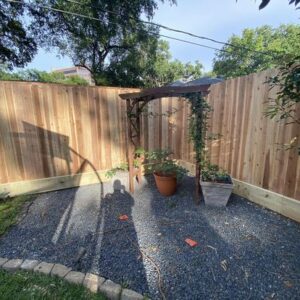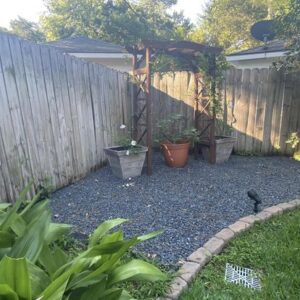 Is Pvc Cheaper Than Wood?
Is Pvc Cheaper Than Wood?
When it comes to home improvement projects, you want to make sure you’re getting the most bang for your buck. And that’s why the question of whether PVC is cheaper than wood often arises.
As you stand in the aisle of your local hardware store, pondering between the two options, you can’t help but wonder which one will save you more money in the long run.
Well, fear not, because in this discussion, we will delve into the cost comparison, maintenance expenses, and other factors that affect the affordability of PVC and wood fencing options for your custom wood fence in Houston TX
So, let’s explore this debate and find out if PVC truly emerges as the more budget-friendly choice.
Cost Comparison: Material and Installation Expenses
When comparing the costs of materials and installation, PVC is often found to be cheaper than wood. The cost of materials is a significant factor when considering which material to choose for your project. PVC, or polyvinyl chloride, is a synthetic plastic that’s readily available and less expensive compared to wood. PVC is manufactured in large quantities, making it more affordable for consumers. On the other hand, wood can be more costly due to its limited availability and higher demand.
Additionally, installation expenses should be taken into account. PVC is lightweight and easy to work with, which means installation can be quick and hassle-free. Wood, on the other hand, requires more labor and expertise, which can increase the overall installation costs.
Long-Term Maintenance Costs
If you choose PVC over wood for your project, you’ll be pleased to know that long-term maintenance costs are significantly lower.
When it comes to maintenance, PVC trim has a clear advantage over wood trim. Unlike wood, PVC doesn’t require regular painting or staining to protect it from the elements. This means you can save both time and money on maintenance tasks.
PVC trim is resistant to rot, insects, and moisture, which are common issues faced by wood trim. With wood trim, you may need to spend money on repairs or replacements due to rot or insect damage. PVC trim, on the other hand, is durable and long-lasting, requiring minimal upkeep.
In the long run, the savings on maintenance costs can add up, making PVC a more cost-effective choice. Additionally, PVC trim is easy to clean and maintain its appearance over time, further reducing the need for costly repairs or replacements.
Factors Affecting Affordability: Durability and Lifespan
One important factor that affects the affordability of PVC compared to wood is its durability and lifespan. When considering which material to choose for your project, it’s crucial to understand the long-term implications and costs associated with each option.
Here are three reasons why PVC can be a more affordable option in terms of durability and lifespan:
- Long-lasting: PVC is known for its durability and resistance to rot, insects, and weathering. Unlike wood, which can deteriorate over time, PVC can maintain its structural integrity for many years, reducing the need for frequent repairs or replacements.
- Low maintenance: PVC requires minimal maintenance compared to wood. Unlike wood, which needs to be regularly painted, stained, or sealed, PVC requires only occasional cleaning with soap and water. This can save you both time and money in the long run.
- Cost advantage: Although PVC might have a higher upfront cost compared to wood, its long lifespan and low maintenance requirements can make it a more cost-effective choice over time. The money saved on maintenance and replacement costs can outweigh the initial investment.

Versatility and Customization Options
PVC offers a wide range of versatile options for customization to suit your specific project needs. When it comes to versatility, PVC outshines wood in many ways. Unlike wood, PVC can be easily molded and shaped into various designs, making it ideal for creating unique and intricate details. Whether you’re looking to add decorative trim, intricate patterns, or smooth curves, PVC can be customized to achieve the desired look.
Furthermore, PVC offers a wide variety of color options, allowing you to choose the perfect shade to complement your project. Unlike wood, which may require staining or painting to achieve the desired color, PVC comes in a range of colors that are fade-resistant and require minimal maintenance.
Another advantage of PVC is its resistance to moisture and decay. Wood, on the other hand, is susceptible to rot and insect infestation, which can compromise its structural integrity. By choosing PVC, you can ensure that your project will withstand the test of time and remain in excellent condition for years to come.
Final Verdict: Is PVC Truly Cheaper Than Wood?
Now let’s take a closer look at the question of whether PVC is truly a more cost-effective option compared to wood. When considering the final verdict, it’s important to consider the context and specific needs of your project. Here are a few factors to consider:
- Durability: PVC is known for its durability, as it’s resistant to rot, insects, and moisture. This can result in lower maintenance costs compared to wood, which may require regular sealing and repairs.
- Lifespan: PVC has a longer lifespan than wood, meaning you may not have to replace or repair it as frequently. This can lead to long-term cost savings.
- Initial cost: While PVC may have a higher initial cost compared to wood, it’s worth considering the long-term savings in maintenance and replacement expenses.
To delve further into cost-effective fencing solutions, read our article on How Much Is 200 Feet of Fence?
Frequently Asked Questions
How Does the Cost of PVC Compare to Other Alternative Materials, Such as Composite or Aluminum?
When comparing the cost of PVC to other alternative materials like composite or aluminum, it’s important to consider factors such as durability, maintenance, and installation expenses. These variables can vary and impact the overall cost.
Are There Any Hidden Costs Associated With the Installation of PVC, Such as Additional Tools or Specialized Labor?
When installing PVC, you won’t have to worry about hidden costs like extra tools or specialized labor. It’s a cost-effective choice, without any surprises that could throw off your budget.
Can PVC Be Used for Outdoor Applications, Such as Decking or Fencing, Without Incurring Extra Expenses for Weatherproofing or Treatments?
When considering outdoor applications like decking or fencing, PVC can be a cost-effective option. It doesn’t require extra expenses for weatherproofing or treatments, making it a convenient choice for your outdoor needs.
Are There Any Specific Factors That Could Make Wood More Affordable in Certain Circumstances, Despite PVC Generally Being Considered Cheaper?
In certain circumstances, wood may be more affordable than PVC, despite PVC generally being considered cheaper. Factors like local availability, installation costs, and maintenance expenses can influence the overall cost.
Is There a Significant Price Difference Between Different Types or Grades of PVC, and How Does This Impact the Overall Cost Comparison With Wood?
There is a significant price difference between different types or grades of PVC, which impacts the overall cost comparison with wood. It’s important to consider these variations when determining which material is cheaper for your specific needs.
Conclusion
So, is PVC truly cheaper than wood?
According to a study, PVC can save you up to 30% on installation costs compared to wood. This statistic highlights the significant cost advantage of PVC, which can evoke a sense of excitement and relief for those looking for a more affordable option.
